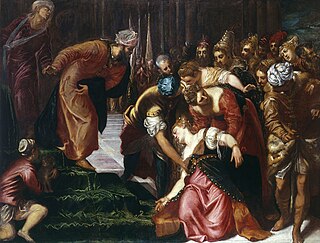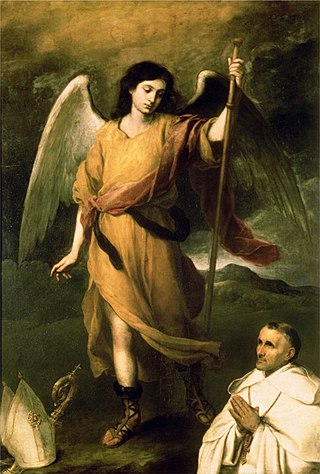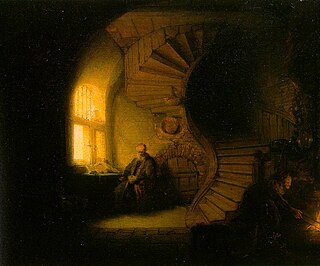
The Book of Nahum is the seventh book of the 12 minor prophets of the Hebrew Bible. It is attributed to the prophet Nahum, and was probably written in Jerusalem in the 7th century BC.

Ahasuerus is a name applied in the Hebrew Bible to three rulers and to a Babylonian official in the Book of Tobit.

The Book of Tobit, also known as the Book of Tobias or the Book of Tobi, is a 3rd or early 2nd century BC Jewish work describing how God tests the faithful, responds to prayers, and protects the covenant community. It tells the story of two Israelite families, that of the blind Tobit in Nineveh and of the abandoned Sarah in Ecbatana. Tobit's son Tobias is sent to retrieve ten silver talents that Tobit once left in Rages, a town in Media; guided and aided by the angel Raphael he arrives in Ecbatana, where he meets Sarah. A demon named Asmodeus has fallen in love with her and kills anyone she intends to marry, but with the aid of Raphael the demon is exorcised and Tobias and Sarah marry, after which they return to Nineveh where Tobit is cured of his blindness.

Asmodeus or Ashmedai, is a prince of demons and hell. In Judeo-Islamic lore he is the king of both daemons (jinn/shedim) and demons (divs). Asmodeus is mostly known from the deuterocanonical Book of Tobit, in which he is the primary antagonist, or the Ars Goetia. In Peter Binsfeld's classification of demons, Asmodeus represents lust. The demon is also mentioned in some Talmudic legends; for instance, in the story of the construction of the Temple of Solomon. In Islam, he is identified with the "puppet" mentioned in the Quran, which dethroned Solomon and reigned over his kingdom until he got his kingship back.

Raphael is an archangel first mentioned in the Book of Tobit and in 1 Enoch, both estimated to date from between the 3rd and 2nd century BCE. In later Jewish tradition, he became identified as one of the three heavenly visitors entertained by Abraham at the Oak of Mamre. He is not named in either the New Testament or the Quran, but later Christian tradition identified him with healing and as the angel who stirred waters in the Pool of Bethesda in John 5:2–4, and in Islam, where his name is Israfil, he is understood to be the unnamed angel of Quran 6:73, standing eternally with a trumpet to his lips, ready to announce the Day of Judgment. In Gnostic tradition, Raphael is represented on the Ophite Diagram.
Azariah is the name of several people in the Hebrew Bible and Jewish history, including:
Econometric models are statistical models used in econometrics. An econometric model specifies the statistical relationship that is believed to hold between the various economic quantities pertaining to a particular economic phenomenon. An econometric model can be derived from a deterministic economic model by allowing for uncertainty, or from an economic model which itself is stochastic. However, it is also possible to use econometric models that are not tied to any specific economic theory.
The non-canonical books referenced in the Bible includes non-Biblical cultures, and lost works of known or unknown status. By the "Bible" is meant those books recognised by most Christians and Jews as being part of Old Testament as well as those recognised by Christians alone as being part of the Biblical apocrypha or of the Deuterocanon.
In statistics, a tobit model is any of a class of regression models in which the observed range of the dependent variable is censored in some way. The term was coined by Arthur Goldberger in reference to James Tobin, who developed the model in 1958 to mitigate the problem of zero-inflated data for observations of household expenditure on durable goods. Because Tobin's method can be easily extended to handle truncated and other non-randomly selected samples, some authors adopt a broader definition of the tobit model that includes these cases.

The concept of Seven Archangels is found in some works of early Jewish literature and in Christianity. In those texts, they are referenced as the angels who serve God directly.
Censored regression models are a class of models in which the dependent variable is censored above or below a certain threshold. A commonly used likelihood-based model to accommodate to a censored sample is the Tobit model, but quantile and nonparametric estimators have also been developed. These and other censored regression models are often confused with truncated regression models. Truncated regression models are used for data where whole observations are missing so that the values for the dependent and the independent variables are unknown. Censored regression models are used for data where only the value for the dependent variable is unknown while the values of the independent variables are still available.
Asmodeus is a demon-like figure from the Book of Tobit.
Tobias and the Angel, described by its composer as a "church opera", is a community opera in one act by Jonathan Dove, with a libretto by David Lan. It premiered on 7 July 1999 in London at Christ Church Highbury. The story is based on the Book of Tobit from the Biblical apocrypha.
A limited dependent variable is a variable whose range of possible values is "restricted in some important way." In econometrics, the term is often used when estimation of the relationship between the limited dependent variable of interest and other variables requires methods that take this restriction into account. For example, this may arise when the variable of interest is constrained to lie between zero and one, as in the case of a probability, or is constrained to be positive, as in the case of wages or hours worked.
Tobias and the Angel is a theme in art taken from the Book of Tobit. It may refer to a number of works of art and music, including:

Madonna of the Fish, known also as Madonna with the Fish is a painting by the High Renaissance master Raphael.

Philosopher in Meditation, recently renamed Philosopher in Contemplation by the museum, is the traditional title of an oil painting in the Musée du Louvre, Paris, that is attributed to the 17th-century Dutch artist Rembrandt.
Anael is an alternative name for the angel or archangel Haniel.
In econometrics, the truncated normal hurdle model is a variant of the Tobit model and was first proposed by Cragg in 1971.

Tobias' Journey is an oil on panel painting by Flemish artist Joos de Momper. The painting showcases Momper's large scale, imaginary landscape painting and his interpretation of perspective in distant views while at the same time treating a biblical subject. The painting depicts the story of Tobit, a righteous Israelite of the tribe of Naphtali, living in Nineveh, who is sent to recover is father's money to Media, escorted by the Archangel Raphael. The painting is currently housed at the Rockox House in Antwerp.








